Efficient degradation of organic pollutants and hydrogen evolution by g-C3N4 using melamine as the precursor and urea as the modifier†
Abstract
Graphitic carbon nitride (g-C3N4) is an important photocatalyst; however the photocatalytic ability of pure g-C3N4 is restricted by rapid charge recombination and low specific surface area. To overcome the issue, we developed a facile and eco-friendly method to prepare g-C3N4 using melamine as the precursor and urea as the modifier. The samples were investigated by XRD, FTIR, SEM, TEM, EIS, UV-vis DRS, valence band XPS (VB-XPS) and Mott–Schottky plots. The results show that the urea-treated g-C3N4 has greatly improved photocatalytic efficiency. Compared with bulk-C3N4, the degradation rate was enhanced 7.2 and 3.7 times for Rhodamine B and methyl orange under visible-light irradiation. The as-prepared photocatalyst also showed a high rate of hydrogen evolution (498.9 μmol h−1 g−1) under visible light. The enhanced photocatalytic performance is attributed to both the increased specific surface area and efficient charge separation and transfer across the heterojunction. Due to the treatment with urea, g-C3N4/g-C3N4 isotypeheterojunction is formed, and the transfer of the photogenerated electrons and holes is driven by the conduction band offset of 0.49 eV and the valence band offset of 0.57 eV, respectively, which is confirmed by both VB-XPS and Mott–Schottky plots. This work demonstrates that graphitic carbon nitride with isotypeheterojunction is an excellent metal-free photocatalyst due to its visible-light-driven bandgap and suitable band edges, and leads the way for development of other efficient visible-light photocatalysts.


 Please wait while we load your content...
Please wait while we load your content...